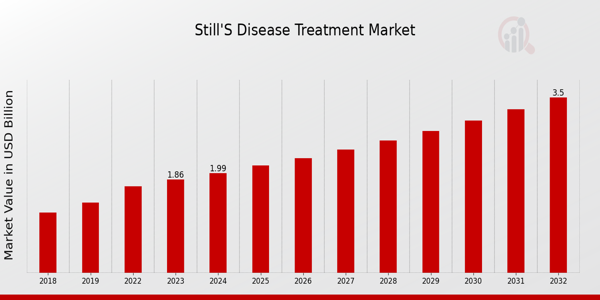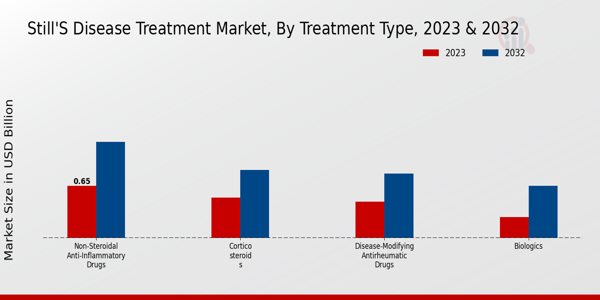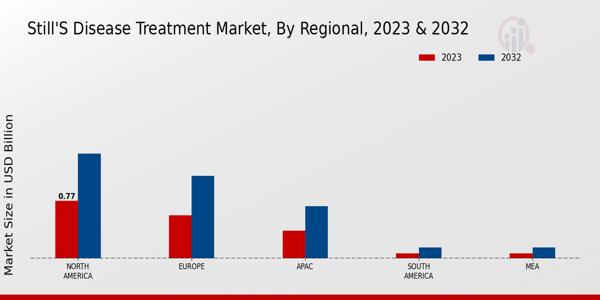Still's Disease Treatment Market Overview
As per MRFR analysis, the Still's Disease Treatment Market Size was estimated at 1.73 (USD Billion) in 2022. The Still's Disease Treatment Market Industry is expected to grow from 1.86(USD Billion) in 2023 to 3.5 (USD Billion) by 2032. The Still's Disease Treatment Market CAGR (growth rate) is expected to be around 7.3% during the forecast period (2024 - 2032).
Key Still's Disease Treatment Market Trends Highlighted
The Still’s Disease Treatment Market has a positive outlook on its growth owing to the increasing rate of Still's disease, which is an auto-inflammatory rare condition. The focus of Healthcare providers is also shifting towards early identification and intervention, which is also resulting in the need for better management options. This increase in demand has been supported by innovations in biologics and specific therapies which allow the patients to control their symptoms more effectively owing to the enhanced quality of services. Furthermore, the rising informing of the healthcare professionals and patients around Still's disease and its treatment options is improving the market conditions. A significant number of avenues are available in this market, including the promise of unique and new treatment methods.
Companies can focus on creating more personalized therapies that cater to specific patient profiles. The rise in investment in research and development activities presents a chance for breakthroughs in effective treatment protocols. Collaborations between biopharmaceutical companies and research institutions may yield innovative solutions. Furthermore, expanding access to existing therapies in underserved regions could significantly boost market growth. As healthcare systems evolve, there will be a greater emphasis on integrated care approaches, opening avenues for comprehensive treatment solutions. In recent times, there has been a noticeable trend towards the use of precision medicine in treating Still's disease.This approach focuses on tailoring treatments to individual patient needs, improving efficacy, and minimizing side effects. The adoption of digital health technologies, including telemedicine, has also gained traction. This allows for improved patient monitoring and management of symptoms remotely, which is particularly beneficial for patients with chronic conditions. Another vital trend is the increasing focus on patient-centric care, ensuring that treatment plans align with the preferences and needs of those affected by Still's disease. These trends indicate a shifting landscape in the way Still's disease is perceived and treated, marking a promising future for patients and healthcare providers alike.

Source: Primary Research, Secondary Research, MRFR Database and Analyst Review
Still's Disease Treatment Market Drivers
Increasing Prevalence of Still's Disease
The growing incidence of Still's Disease globally is one of the primary drivers of the Still’s Disease Treatment Market Industry. As more individuals are being diagnosed with this rare inflammatory condition, there is heightened awareness and an urgent need for effective treatment options. This increase in prevalence is largely attributed to improved diagnostic techniques and increased awareness among healthcare professionals, enabling earlier detection of the disease.As a result, the demand for specialized therapies and medications tailored to address the unique challenges of Still's Disease is rising. The treatment landscape is evolving to include a variety of options, ranging from non-steroidal anti-inflammatory drugs (NSAIDs) to biologic therapies, providing patients with a range of choices. Moreover, ongoing research and development efforts are leading to innovative treatments that promise to enhance the quality of life for patients.Such developments boost investor interest and stimulate market growth as new therapies become available in the coming years. Overall, the increasing prevalence of Still's Disease directly correlates with the growth potential of the Still’s Disease Treatment Market, indicating a robust future trajectory for the industry.
Advancements in Treatment Options
Advancements in medical research and technology are playing a significant role in shaping the Still’s Disease Treatment Market Industry. Innovative therapies, particularly biological agents and targeted therapies are gaining traction due to their efficacy in managing symptoms and improving patient outcomes. These advancements not only enhance treatment options for patients but also offer promising avenues for pharmaceutical companies to explore.As new medications and combinations enter the market, the competitive landscape is expected to become more dynamic, fostering innovation and expanding the choices available to patients.
Growing Awareness and Education
There is an increasing emphasis on raising awareness of Still's Disease among healthcare providers and patients. Educational initiatives aimed at better understanding the disease, its symptoms, and treatment options are crucial for timely diagnosis and management. This surge in awareness is prompting healthcare professionals to pursue further education and training, leading to improved patient outcomes. As understanding surrounding the Still’s Disease Treatment Market Industry grows, it encourages investment in research and development, as well as the establishment of support networks for patients and their families.
Still's Disease Treatment Market Segment Insights
Still's Disease Treatment Market Treatment Type Insights
The Still’s Disease Treatment Market is poised for growth as various treatment types cater to the needs of patients facing this complex disease. In 2023, the market for Non-Steroidal Anti-Inflammatory Drugs (NSAIDs) is valued at 0.65 USD Billion, reflecting their essential role in managing pain and inflammation associated with Still's disease, allowing them to hold a significant majority in the treatment landscape.
By 2032, their valuation is expected to rise to 1.2 USD Billion, indicating a continued demand driven by the need for effective symptomatic relief. Corticosteroids emerge as another crucial treatment type, valued at 0.5 USD Billion in 2023 and projected to reach 0.85 USD Billion by 2032. Their effectiveness in rapidly reducing inflammation makes them an essential choice for acute management, thereby maintaining a significant market position.Disease-modifying antirheumatic Drugs (DMARDs) also constitute a vital segment of the market.
With a valuation of 0.45 USD Billion in 2023, expected to grow to 0.8 USD Billion by 2032, DMARDs are important for their long-term management capabilities, addressing the underlying mechanisms of Still's disease rather than just its symptoms. This long-term benefit highlights their significance within the treatment spectrum, although they hold a slightly lower market share compared to NSAIDs and corticosteroids.
Finally, Biologics, valued at 0.26 USD Billion in 2023 and expected to grow to 0.65 USD Billion by 2032, represents an emerging area of treatment with targeted therapy options that can significantly impact disease progression. Despite being the smallest segment, their increasing acceptance in clinical settings points to opportunities for growth driven by ongoing advancements in biotechnology.
Overall, the Still’s Disease Treatment Market segmentation indicates that while traditional approaches like NSAIDs and corticosteroids dominate due to their immediate effectiveness and easing symptoms, there is a notable upward trend in the adoption of DMARDs and biologics as more patients seek comprehensive treatment strategies. The interplay of these treatment types shapes the market's dynamics, indicating a growing emphasis on long-term disease management and personalized therapies in addressing Still's disease effectively.
Such trends will likely inform future strategies in the marketplace and influence patient treatment decisions, ensuring that the Still’s Disease Treatment Market continues to evolve. Market growth is anticipated as healthcare providers adapt to these treatment modalities, supported by ongoing research and a better understanding of Still's disease, ultimately enhancing patient outcomes within this segment.

Source: Primary Research, Secondary Research, MRFR Database and Analyst Review
Still's Disease Treatment Market Route of Administration Insights
The Still’s Disease Treatment Market is witnessing significant advancements in the Route of Administration segment, with the overall market expected to be valued at 1.86 USD Billion in 2023. This segment includes various methods of delivering treatments effectively to patients, playing a crucial role in adherence and therapeutic success. Among the methods, oral administration is favored for its convenience and ease of use, often leading to higher patient compliance. Intravenous administration holds importance in acute cases needing rapid action, thus gaining traction for its effectiveness in critical settings.Subcutaneous administration has also emerged as a significant option, particularly for biologics, as it allows for self-administration and better management of treatment regimens. The growth drivers for this segment include the rising prevalence of Still's disease and advancements in drug formulation technology, while challenges such as patient-specific responses and treatment accessibility persist. The Still’s Disease Treatment Market data reflects a strong trend towards innovative delivery methods, indicating a focus on enhancing patient care and treatment outcomes in this evolving industry.Factors contributing to market growth encompass the demand for personalized therapies and the introduction of new therapeutic agents.
Still's Disease Treatment Market Patient Age Group Insights
The Still’s Disease Treatment Market, valued at 1.86 billion USD in 2023, demonstrates a significant focus on various Patient Age Groups, specifically Pediatric and Adult. The Pediatric segment plays a crucial role due to the unique challenges faced by younger patients who may require specialized treatments that cater to their developmental needs. Additionally, the Adult segment remains a prominent participant within the market, largely driven by increasing diagnoses of Still's Disease among adults. The market's growth is propelled by rising awareness and advancements in therapy options, catering to the diverse requirements of both age groups.With the adult population often representing a majority in the treatment landscape, it underscores the need for targeted medications and support systems. This segmentation allows for tailored approaches that enhance treatment efficacy and patient outcomes, contributing positively to the overall Still’s Disease Treatment Market revenue. As the market evolves, trends point towards expanding options in therapeutic avenues designed for each age group, highlighting both challenges and unique opportunities for growth. Collectively, the segments represent valuable insights into the market dynamics guiding the Still’s Disease Treatment Market industry.
Still's Disease Treatment Market End User Insights
The Still’s Disease Treatment Market revenue is expected to reach 1.86 USD Billion in 2023, reflecting a steady demand across various end users, primarily Hospitals, Clinics, and Homecare Settings. Hospitals play a critical role in administering specialized treatments and care for Still's Disease, contributing significantly to the market's growth due to their capacity to support advanced medical procedures. Clinics also represent a vital touchpoint for patients seeking tailored treatments and ongoing care, enhancing the accessibility of services.Meanwhile, care settings are gaining traction as patients increasingly prefer personalized treatment in comfortable environments, embodying a trend toward patient-centered care. The diversity across these end users highlights the market's robust segmentation, emphasizing the critical avenues through which healthcare services are delivered in the context of Still's Disease treatment. As the Still’s Disease Treatment Market evolves, it is anticipated that the interplay among these segments will underpin the industry's expansion, with each catering to unique patient needs and preferences.
Still's Disease Treatment Market Regional Insights
The Still’s Disease Treatment Market is poised for substantial growth, with a market valuation of 1.86 USD Billion in 2023. The Regional segmentation reveals that North America dominates this market, holding a significant value of 0.77 USD Billion in 2023 and expected to reach 1.4 USD Billion by 2032, showcasing a strong demand for treatment options. Europe follows, with a notable valuation of 0.58 USD Billion in 2023, anticipated to grow to 1.1 USD Billion in 2032, reflecting an increasing awareness and investment in healthcare solutions for Still's Disease.In the Asia-Pacific (APAC) region, the market stands at 0.37 USD Billion in 2023, with growth to 0.7 USD Billion in 2032, indicating heightened healthcare advancements and patient awareness. South America and the Middle East Africa (MEA) each reflect smaller market valuations of 0.07 USD Billion in 2023, expected to increase to 0.15 USD Billion by 2032.
These figures highlight the varying levels of market penetration and emphasize the importance of developing treatment frameworks in less dominant regions. Overall, the Still’s Disease Treatment Market revenue in different regions showcases a solid growth trajectory fueled by a rising prevalence of the disease, improved healthcare infrastructure, and increasing investments in research and development.

Source: Primary Research, Secondary Research, MRFR Database and Analyst Review
Still's Disease Treatment Market Key Players and Competitive Insights
The Still’s Disease Treatment Market has gained significant attention due to the growing prevalence of this rare autoimmune disorder characterized by persistent fever, rash, and arthritis. This market encompasses various therapeutic approaches, including biologics, corticosteroids, and nonsteroidal anti-inflammatory drugs, aimed at managing symptoms and improving the quality of life for affected patients. The competitive landscape is influenced by factors such as innovative drug formulations, advancements in clinical research, and strategic partnerships among pharmaceutical companies. As demand for effective treatments rises, stakeholders are increasingly focusing on understanding their competitors' capabilities, market positioning, and therapeutic offerings to secure a significant foothold in this niche market. Within this competitive framework, Pfizer stands out with its strong presence in the Still’s Disease Treatment Market owing to its robust RD capabilities and extensive product portfolio. The company has committed significant resources to developing cutting-edge therapies that cater to the particular needs of patients suffering from Still's disease, leveraging its expertise in immunology to create effective treatment options. Pfizer's established relationships with healthcare professionals and institutions further enhance its market penetration and visibility, fostering trust and credibility. In addition, the company's strategic investments in clinical trials and collaborations with research institutions have enabled the development of innovative drugs that offer improved efficacy and safety profiles, solidifying its position as a key player in addressing the challenges posed by this complex condition.Takeda Pharmaceutical has also emerged as a prominent contributor to the Still’s Disease Treatment Market, characterized by its dedication to developing therapies for rare diseases, including Still's disease. The company boasts a strong commitment to patient-centric approaches and has established thorough research programs to advance the treatment landscape significantly. Takeda's strengths lie in its comprehensive pipeline of biologics and targeted therapies designed to address unmet medical needs, positioning it strategically within this specialized market. Moreover, the company's global reach and established reputation for quality enable it to engage effectively with healthcare providers and patients alike, ensuring that its innovative treatments reach those who need them most. Through ongoing investment in research and development and a focus on collaboration with medical communities, Takeda Pharmaceutical continues to play a vital role in transforming the treatment paradigm for Still's disease.
Key Companies in the Still's Disease Treatment Market Include
- Pfizer
- Takeda Pharmaceutical
- Amgen
- Merck
- UCB
- Eli Lilly
- Celgene
- AbbVie
- Janssen Pharmaceuticals
- GSK
- Roche
- AstraZeneca
- Novartis
- Bristol-Myers Squibb
- Sanofi
Still's Disease Treatment Market Industry Developments
The Still’s Disease Treatment Market has experienced significant activity recently, particularly with advancements from key players, including Pfizer, Takeda Pharmaceutical, and Amgen. New clinical trial results for innovative therapies targeting Still's Disease have emerged, demonstrating promising efficacy and safety profiles that could lead to enhanced treatment options for patients. UCB and Eli Lilly are also exploring next-generation biologics, contributing to the market's dynamic landscape. In terms of mergers and acquisitions, recent consolidation trends have been observed, particularly with major players like AbbVie and Roche strategically aligning to enhance their portfolios in immunology. The market valuation for Still's Disease treatments is expected to grow substantially, reflecting increased R&D investment and heightened demand for effective therapies. This surge in market growth is anticipated to not only bolster the revenues of participating companies but also stimulate competitive dynamics within the healthcare sector. Reports indicate that continued collaborations and partnerships among these prominent companies, such as Janssen Pharmaceuticals, GSK, and Novartis, are likely to drive further innovations, ensuring the availability of more targeted and effective treatment modalities for those suffering from Still's Disease.
Still's Disease Treatment Market Segmentation Insights
Still's Disease Treatment Market Treatment Type Outlook
- Non-Steroidal Anti-Inflammatory Drugs
- Corticosteroids
- Disease-Modifying Antirheumatic Drugs
- Biologics
Still's Disease Treatment Market Route of Administration Outlook
- Oral
- Intravenous
- Subcutaneous
Still's Disease Treatment Market Patient Age Group Outlook
Still's Disease Treatment Market End User Outlook
- Hospitals
- Clinics
- Homecare Settings
Still's Disease Treatment Market Regional Outlook
- North America
- Europe
- South America
- Asia-Pacific
- Middle East and Africa
| Report Attribute/Metric |
Details |
| Market Size 2022 |
1.73(USD Billion) |
| Market Size 2023 |
1.86(USD Billion) |
| Market Size 2032 |
3.5(USD Billion) |
| Compound Annual Growth Rate (CAGR) |
7.3% (2024 - 2032) |
| Report Coverage |
Revenue Forecast, Competitive Landscape, Growth Factors, and Trends |
| Base Year |
2023 |
| Market Forecast Period |
2024 - 2032 |
| Historical Data |
2019 - 2022 |
| Market Forecast Units |
USD Billion |
| Key Companies Profiled |
Pfizer, Takeda Pharmaceutical, Amgen, Merck, UCB, Eli Lilly, Celgene, AbbVie, Janssen Pharmaceuticals, GSK, Roche, AstraZeneca, Novartis, Bristol-Myers Squibb, Sanofi |
| Segments Covered |
Treatment Type, Route of Administration, Patient Age Group, End User, Regional |
| Key Market Opportunities |
Biologic therapies development, Expanded patient access programs, Innovative diagnostics technologies, Increased awareness and education, and Personalized medicine approaches. |
| Key Market Dynamics |
Rising prevalence of Still's disease, Advancements in treatment options, Increasing research funding initiatives, Growing awareness and diagnosis, High unmet medical needs |
| Countries Covered |
North America, Europe, APAC, South America, MEA |
Frequently Asked Questions (FAQ) :
By 2032, the market is anticipated to reach a valuation of 3.5 USD Billion.
The market is projected to Register a CAGR of 7.3% from 2024 to 2032.
North America is projected to dominate the market with a value of 1.4 USD Billion in 2032.
The market for Non-Steroidal Anti-Inflammatory Drugs is expected to reach 1.2 USD Billion by 2032.
Major players include Pfizer, Takeda Pharmaceutical, Amgen, Merck, UCB, and Eli Lilly among others.
The market for Biologics is projected to be valued at 0.65 USD Billion by 2032.
The European market is expected to grow from 0.58 USD Billion in 2023 to 1.1 USD Billion in 2032.
The market for Disease-Modifying Antirheumatic Drugs is anticipated to reach 0.8 USD Billion by 2032.
The market faces challenges such as high treatment costs while presenting opportunities for innovation and tailored therapies.















